


QUBIT AI: Eduardo Reck Miranda
Sounding Qubits
FILE 2024 | Quantico
International Electronic Language Festival
Eduardo Reck Miranda – Sounding Qubits – Brazil
Although he has learned classical musical instruments since childhood, Eduardo Miranda’s favorite tool for composing is the computer. The researcher has been delving into artificial intelligence and innovative computing methods for compositing for some time, as they offer fresh insights and ideas beyond his own.
A quantum computer deals with information encoded as qubits. A qubit is to a quantum computer what a bit is to a digital one: a basic unit of information. In hardware, qubits exist in the subatomic world. They are subject to the laws of quantum mechanics.
Quantum computers are like super-powered versions of classical digital computers. While a digital computer processes data in a linear, step-by-step fashion, a quantum computer can explore many possibilities at once.
Operating a quantum computer requires different ways of thinking about encoding and processing information. This is where composers can benefit greatly. This technology is destined to facilitate the development of unprecedented ways of creating music.
Bio
Composer who works at the intersection of music, science and new technologies. His background as an artificial intelligence scientist and classical composer with early involvement in avant-garde pop music informs his distinctive music. He has composed for BBC Radio 3, BBC Concert Orchestra, BBC Singers and Scottish Chamber Orchestra. He is a professor at the University of Plymouth and a research associate at Quantinuum, where he explores music composition with quantum computers.


Refik Anadol
Quantum memories
Quantum Memories is Refik Anadol Studio’s epic scale investigation of the intersection between Google AI Quantum Supremacy experiments, machine learning, and aesthetics of probability. Technological and digital advancements of the past century could as well be defined by the humanity’s eagerness to make machines go to places that humans could not go, including the spaces inside our minds and the non-spaces of our un- or sub-conscious acts. Quantum Memories utilizes the most cutting-edge, Google AI’s publicly available quantum computation research data and algorithms to explore the possibility of a parallel world by processing approximately 200 million nature and landscape images through artificial intelligence. These algorithms allow us to speculate alternative modalities inside the most sophisticated computer available, and create new quantum noise-generated datasets as building blocks of these modalities. The 3D visual piece is accompanied by an audio experience that is also based on quantum noise–generated data, offering an immersive experience that further challenges the notion of mutual exclusivity. The project is both inspired by and a speculation of the Many-Worlds Interpretation in quantum physics – a theory that holds that there are many parallel worlds that exist at the same space and time as our own.

localStyle (Marlena Novak & Jay Alan Yim) in collaboration with Malcolm MacIver
Scale
‘scale’ is an interspecies art project: an audience-interactive installation that involves nocturnal electric fish from the Amazon River Basin. Twelve different species of these fish comprise a choir whose sonified electrical fields provide the source tones for an immersive audiovisual environment. The fish are housed in individual tanks configured in a custom-built sculptural arc of aluminum frames placed around a central podium. The electrical field from each fish is translated into sound, and is thus heard — unprocessed or with digital effects added, with immediate control over volume via a touchscreen panel — through a 12-channel surround sound system, and with LED arrays under each tank for visual feedback. All software is custom-designed. Audience members interact as deejays with the system. Amongst the goals of the project is our desire to foster wider public awareness of these remarkable creatures, their importance to the field of neurological research, and the fragility of their native ecosystem.The project leaders comprise visual/conceptual artist Marlena Novak, composer/sound designer Jay Alan Yim, and neural engineer Malcolm MacIver. MacIver’s research focuses on sensory processing and locomotion in electric fish and translating this research into bio-inspired technologies for sensing and underwater propulsion through advanced fish robots. Novak and Yim, collaborating as ‘localStyle’, make intermedia works that explore perceptual themes, addressing both physical and psychological thresholds in the context of behavior, society/politics, and aesthetics.

Mika Tajima
New Humans
In New Humans, emergent gatherings of synthetic humans rise from the surface of a black ferrofluid pool. Appearing to morph like a supernatural life form, these dynamic clusters of magnetic liquid produced by machine learning processes are images of communities of synthetic people–hybrid profiles modeled from actual DNA, fitness, and dating profile data sets sourced from public and leaked caches. The work questions how we can radically conceptualize the “user profile” to embody a self whose bounds are indefinable and multiple. Generative algorithm using machine learning (GAN, T-SNE) and fluid simulation (Navier Stokes), countour generation (OpenCV), user profile data caches (DNA, fitness, and dating), software production (Processing), ferrofluid, custom electromagnet matrix, custom PCB control system, computer, steel, wood, aluminum.
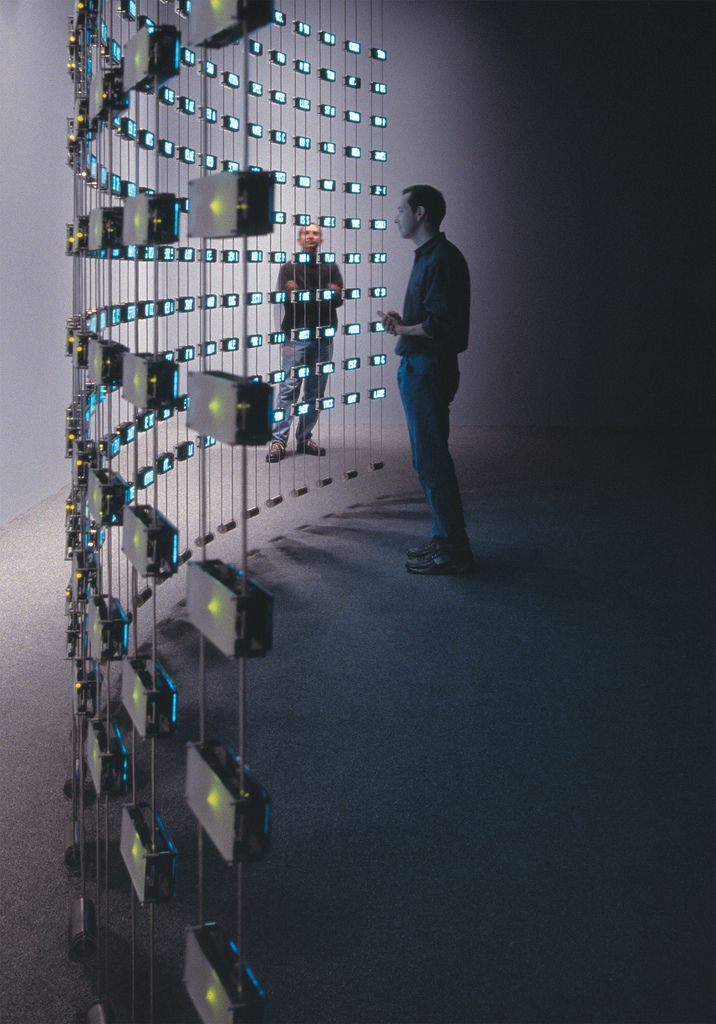
MARK HANSEN & BEN RUBIN
Марк Хансен и Бен Рубин
마르크 한센과 벤 루빈
Listening Post
Listening Post is an art installation by Mark Hansen and Ben Rubin that culls text fragments in real time from thousands of unrestricted Internet chat rooms, bulletin boards and other public forums. The texts are read (or sung) by a voice synthesizer, and simultaneously displayed across a suspended grid of more than two hundred small electronic screens.Listening Post cycles through a series of six movements, each a different arrangement of visual, aural, and musical elements, each with it’s own data processing logic.Dissociating the communication from its conventional on-screen presence, Listening Post is a visual and sonic response to the content, magnitude, and immediacy of virtual communication.

Yoon Chung Han
Eyes
Eyes is an interactive art installation and a series of biometric data artworks with my previous artwork Digiti Sonus. It’s an interactive biometric data art that transforms human’s Iris data into musical sound and 3D animated image. The idea is to allow the audience to explore their own identities through unique visual and sound generated by their iris patterns based on iris recognition and image processing techniques. As a part of the installation, selected distinctive iris images are printed in 3D sculptures, and it replays the sound generated from the iris data and projects 3D converted image images. The audience members can compare their iris-based sonic results with others, and question the “problem of disembodied identities’ in the digital era through the existence of audiovisual representations of individuals.
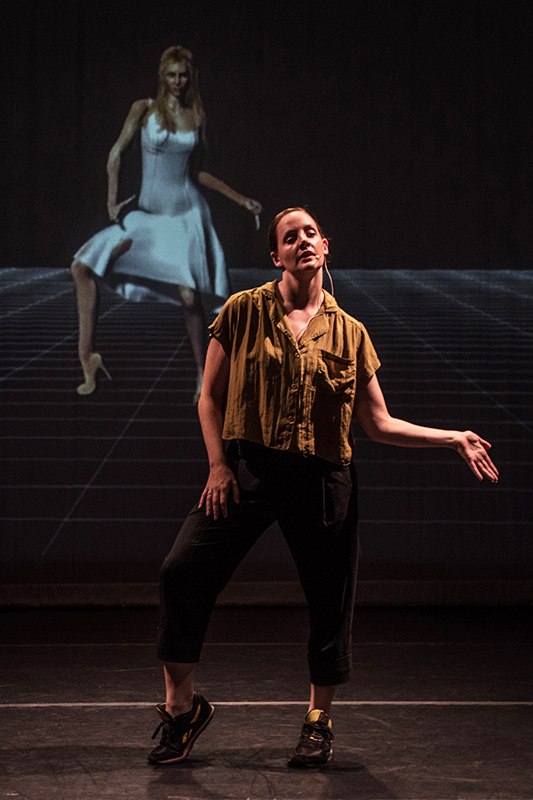
Freya Olafson
MÆ Motion Afterefffect
MÆ – Motion Aftereffect explores motion-capture, ready-made 3D models and monologues found online, ranging from experiences with virtual reality in live gameplay to out-of-body experiences and astral projection tutorials. The work addresses the impact of emerging consumer technologies associated with AR – Augmented Reality, VR – Virtual Reality, MR – Mixed Reality, XR – Extended Reality and 360° video. Monologues sourced from the internet provide the infrastructure for the work; an in-ear monitor feeds Olafson the monologues onstage, challenging her to listen and speak simultaneously. This dual action of listening and speaking enables her to embody a state of presence that references data streaming, live processing, and gaming. As a performer she becomes a conduit, medium, or interface, broadcasting edited monologues from the internet to the audience. The action of performing the work becomes like playing a video or VR game.
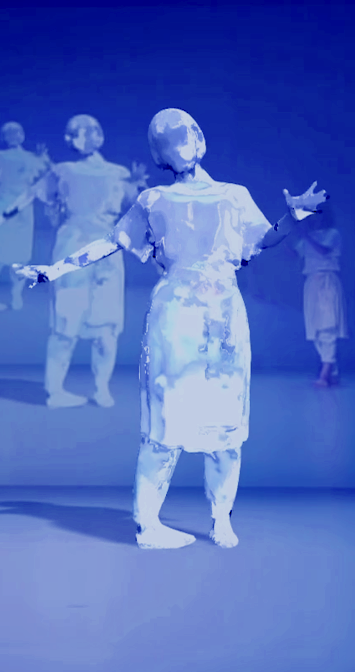
Rhizomatiks Research ELEVENPLAY Kyle McDonald
discrete figures 2019
Human performers meet computer-generated bodies, calculated visualisations of movement meet flitting drones! Artificial intelligence and self-learning machines make this previously unseen palette of movement designs appear, designs that far transcend the boundaries of human articulateness, allowing for a deep glimpse into the abstract world of data processing. The Rhizomatiks Research team, led by Japanese artist, programmer, interaction designer and DJ Daito Manabe, gathers collective power with a number of experts, among them the five ELEVENPLAY dancers of choreographer MIKIKO as well as from coding artist Kyle McDonald. The result is a breathtaking, implemented beautifully, in short: visually stunning.

Khalil Klouche
Monolith
A mysterious object reacts to your presence and touch, turning its surface into a space in which you travel/fall. Made with Arduino, Processing and the CapSense library.
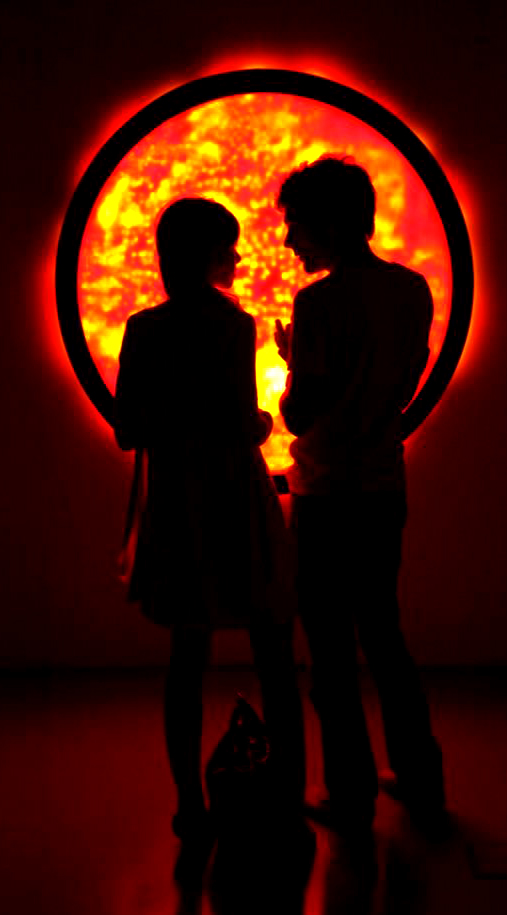
RAFAEL LOZANO HEMMER
Рафаэль Лозано-Хеммер
拉斐尔·洛萨诺 – 亨默
ラファエル·ロサノ=ヘメル
라파엘 로자노
רפאל לוזאנו, המר
Flatsun
A circular display that simulates the turbulence at the surface of the Sun using mathematical equations. The piece reacts to the presence of the public by varying the speed and type of animation displayed. If no one is in front of the piece the turbulence slows down and eventually turns off. As the built-in camera detects people more solar flares are generated and the fake Sun shows more perturbation and activity. At 140 cm diameter, Flatsun is exactly a billion times smaller than the real Sun. The piece consists of custom-made panels with 60,000 red and yellow LED lights, a computer with 8 processing cores, a camera with a pinhole lens and a mechanically engineered aluminium, steel and glass structure that pivots for maintenance. A single knob lets the collector set the brightness of the piece and turn it on and off.
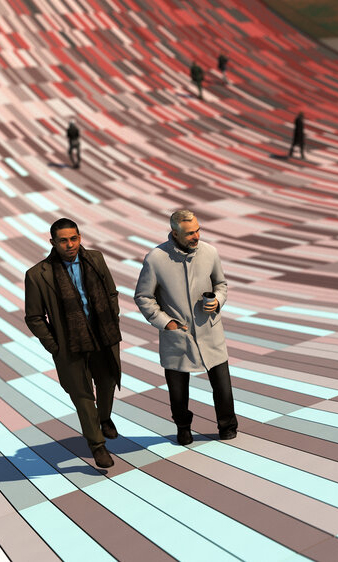
South Georgia Heritage
NEON – Fantastical Architecture, Art and Design
FROM DARKNESS TO LIGHT
South Georgia Heritage Trust launched an open call for a site-specific commission to be located on Grytviken the former whaling station of sub-Antarctic Island of South Georgia. The project was required to celebrate the whale through a reinterpretation of the former Flensing Plan (a large timber deck used to process the captured whales) and offer a message of hope for future generations by demonstrating how humankind can move from exploitation to conservation. Our proposal imagines that the deck of the Flensing plan has been cut like a piece of flesh from the ground and bent upwards to form an arc. The timber deck is replaced with concrete pavers which are coloured based on the activities which took place in the sites past and present (whale processing and whale watching). The coloured pavers are positioned to create a gradient which provides the visitor with a visual representation of the way the site has changed over time.

ADAM FERRISS
“Adam Ferriss is one of those technologically-minded creatives who is able to put his ever-growing knowledge of code and processing to use building aesthetically wondrous digital art for the rest of us to enjoy. His images make me feel like I’ve just taken some psychedelics and stepped into one of those crazy houses you get in funfairs, where there are giant optical illusions on every wall and the floor keeps moving under your feet, except these are made using algorithms and coding frameworks […]”
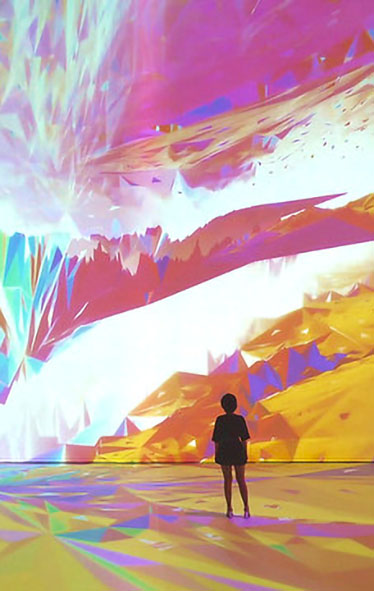
Raven Kwok
1194D^3
Initially started as a tweak of 115C8 in 2013, one of Kwok’s Algorithmic Creatures based on finite subdivision, 1194D is an experiment on multiple geometric creatures co-existing within a tetrahedron-based grid environment. In 2017, The project was improved and revised into an immersive triple-screen audiovisual installation as 1194D^3 for .zip Future Rhapsody art exhibition curated by Wu Juehui & Yan Yan at Today Art Museum in Beijing, China. The entire visual is programmed and generated using Processing. All stages are later composed and exported using Premiere.

Philippe Grammaticopoulos
Les Ventres
This story of “Les Ventres” (“The Bellies”) is a thought about our epoch, an ironic and critical vision of the food-processing industry. The agribusiness uses the scientific progress to make a profit, to the detriment of the public health. The story finds a place in a world polluted and denatured by experiments, where all men eat only giant snails. In this context, a man explores a giant empty shell which becomes the gate of hell.

Philippe Grammaticopoulos
The Bellies
In a very industrialized world, where humans only eat transgenic food, some plates make for surprising dishes… This story is a thought about our epoch, an ironic and critical vision of the food-processing industry. The agribusiness uses the scientific progress to make a profit, to the detriment of the public health. The story finds a place in a world polluted and denatured by experiments, where all men eat only giant snails. In this context, a man explores a giant empty shell which becomes the gate of hell.

FABIANO ONÇA & COLMEIA
Tantalus Quest
file festival
Game designer Fabiano Onça conceived the game, in which people must fill geometric shapes with their own silhouettes (as captured by webcams hanging from the ceiling): Software was built with OpenFrameworks, which is to C++ what Processing is to Java. A prototype was built with Flash (AS3), but it was slow — reading pixel values (BitmapData.getPixel) can be processor-heavy. Thanks to OpenFrameworks, porting the AS3 code to C++ was quite easy. The application is very simple: the images captured by the cameras are brightened, blurred and thresholded, resulting in black blobs. The amount of blob pixels inside the geometric shape count as positive points and the pixels outside the geometric shape count as negative points.

ELLE MOSS
oh, dear
Her pictures describe oniric situations, enchanted, sometimes spooky, but always with a touch of glam. In applaying different photo techniques as mirrored images, photo overlapping, refined photo processing, Elle Moss depicts lonely worlds, often autobiographical, almost exclusively feminine, in which all the characters tell feelings about suspension and alienation, entering into undefined space-time dimensions.
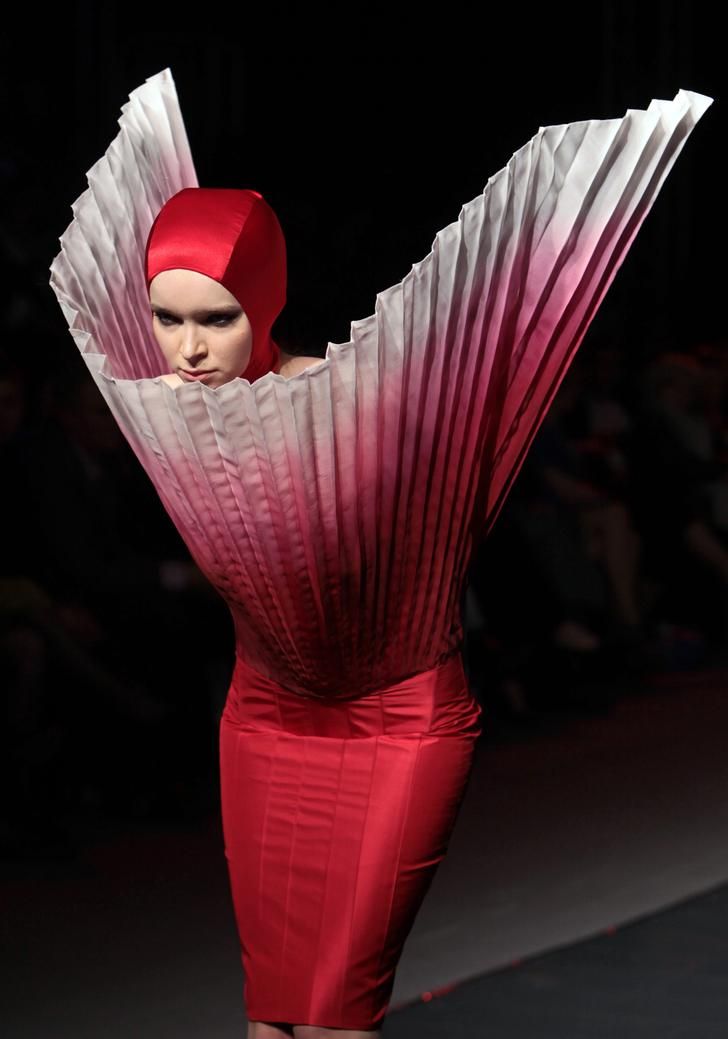
KAMILA GAWRONSKA-KASPERSKA
METROPOLIS
Kamila Gawronska-Kasperska’s collections have stretched the boundaries of Fashion. Her inspiration was drawn from the films Metropolis and Sky Captain. The unique fashion photography by Tomek Slupski, Maciej Boryna and Bartek Sejwa, accentuates the bold geometry of her collections. The city is the backdrop of this stylish, urban and elegant collection, the morphing of fashion and architecture. Black and white with strokes of red are the main colours of her canvas used to experiment with form and fabric processing.
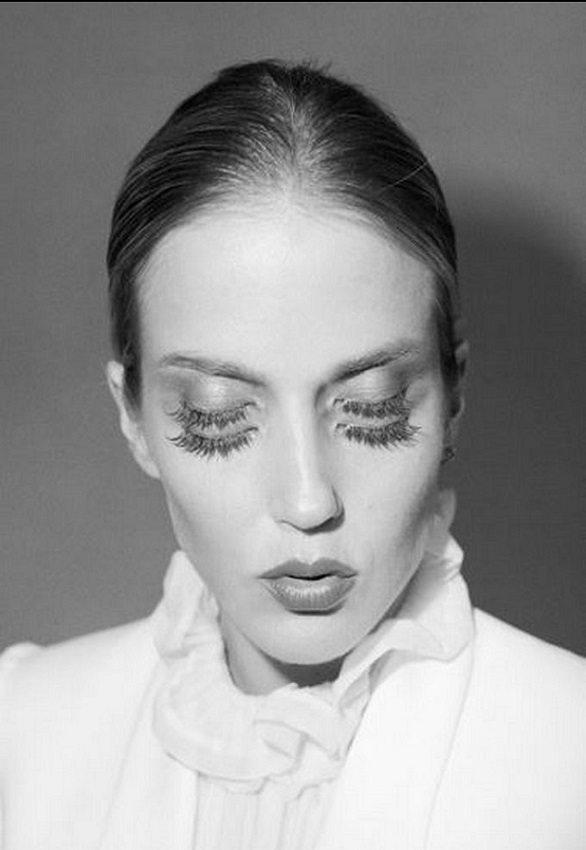
Asger Carlsen
アスガーカールセン
Асгер Карлсен
The work of Danish-born artist Asger Carlsen is a relatively irreverent take on photography. Bodies are bent and contorted through studied post-processing, and scratch at the border of anthropomorphic figuration and abstract form. Originally a photojournalist – and, for a brief stint, a crime scene photographer – in Denmark, Carlsen moved to New York to work as a commercial photographer.


RALF BAECKER
Ральф Беккер
The Conversation
Pataphysical Processing Environment
À travers des installations et des machines, Baecker explore les mécanismes d’action fondamentaux et les effets des nouveaux médias et technologies. Dans ses représentations et spatialisations de processus microscopiques, il cherche à perturber complètement notre perception. Au cœur de ses objets se trouve l’intrication du virtuel avec le réel, ou plutôt avec le monde. Avec une perspective médiatique et archéologique, Ralf Baecker fouille dans des dispositifs obsolètes des traces et des fonctions encore détectables dans les technologies d’aujourd’hui. Son travail cherche à former un hybride entre l’esthétique numérique actuelle et une compréhension historique des matériaux. En conséquence, il appréhende la technologie non pas comme un outil mais plutôt comme un instrument épistémologique, afin de poser des questions élémentaires sur un monde perçu à travers les impressions technologiques.

Susanna Hertrich
Jacobson’s Fabulous Olfactometer
Created by Susanna Hertrich, Jacobson’s Fabulous Olfactometer (JFO) is a sensorial prosthesis that mimics mammalian ‘flehmen’ when air pollution levels are high. The prosthetic is designed around a new human sense modeled after a mammalian sense organ called the vomeronasal or “Jacobson’s” organ. This olfactory sense organ enables certain animals to sense odourless chemicals. When a mammal senses chemicals, it lifts its upper lip to expose this organ. This behaviour is called ‘flehmen’ (wikipedia).Two air chemical sensors located at the top part of the prosthetic register small particles (smoke) and CO2 levels. This data is fed into an Arduino board. When air pollution levels are registered as ‘high’, two stepper motors on either side of the head set exaggerated bone gears in motion and the wearer’s lip is slowly pulled upwards. Thus, JFO enables its wearer to ‘sense’ airborne chemicals and modifies his/her face similar to mammalian flehmen.Sensing and data processing is achieved using an Arduino with a Smoke detector (fine particles) & a Co2 sensor. The device also includes Adafruit stepper motor shield, two stepper motors and a custom designed gears carved from camel bone.

Szilárd Cseke
Multiple Identities, Sustainable Development
The focus is on multiple identities. There are pale, milky plastic pipes attached to the ceiling of the concrete interior, inside which, moved by fans, roll white balls. One after the other. If the one arrives, a new one is sent to another tube.Such works breathe inner unity. This closeness is sometimes a closeness, if not encryption. Because the language of contemporary installation art is foreign and difficult to read. The viewer’s gaze likes to evaluate subjectively and is always shaped by environmental influences such as culture, trends, styles, beliefs, experiences and politics. This makes the interpretation uncertain, it becomes subjective, often tempting to misconduct. Because anyone who claims that the work of art is created in the eye of the beholder and means that everyone, regardless of where they come from and how educated, can make a valid statement about a work of art is wrong. What Marcel DuChamp meant is that it unfolds in the eye of the beholder. But this development should not mean that simply opening the eyes also brings with it knowledge and insight. These qualities are developed through active participation, through perception. This, in turn, is not only feasible through the visual stimulus in the eye. It is possible, however, if you know who the artist is, what he is doing, what he wishes to express and with which underlying design principles the view is guided in what way to what. Only then does the processing take place, a connection of the causal relationships, which ultimately leads to art in the eye of the beholder. To an inner feeling outside of the spontaneous feelings.

Ryota Matsumoto
the Indistinct Notion of an Object Trajectory
Ryota Matsumoto’s drawings develop and demonstrate the hybrid/multi-layered process where varying scale, juxtaposition of different forms, intertwined textures/tones are applied to reinvent and question the spatial conditions of architectural drawings. His work explore a hybrid drawing technique combining both traditional media (ink, acrylic, and graphite) and digital media (algorithmic processing, scripting and image compositing with custom software ) .
FILE FESTIVAL

LISA PARK
Лиза Парк
eunoia
“Eunoia” is a performance that uses my brainwaves — collected via EEG sensor– to manipulate the motions of water. It derives from the Greek word “ey” (well) + “nous” (mind) meaning “beautiful thinking”. EEG is a brainwave detecting sensor. It measures frequencies of my brain activity (Alpha, Beta, Delta, Gamma, Theta) relating to my state of consciousness while wearing it. The data collected from EEG is translated in realtime to modulate vibrations of sound with using software programs. EEG sends the information of my brain activity to Processing, which is linked with Max/MSP to receive data and generate sound from Reaktor.
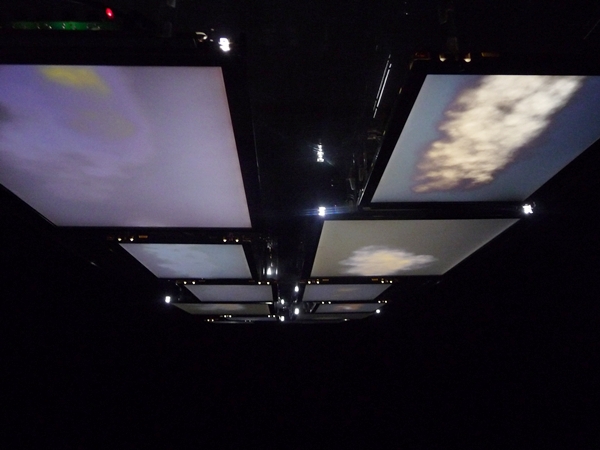
aaajiao
Cloud.data
Created by Aaajiao (Xu Wenkai), a media artist based in Shanghai, cloud.data is an iPhone/iPad app installation inspired by an ancient legend. Using different touch gestures you get to control the passing cloud formations. Single tap allows you to redirect them, double to change their size and three finger drag to adjust opacity. The app is an interactive incarnation of the processing installation Aaajiao created in 2009 (see images).
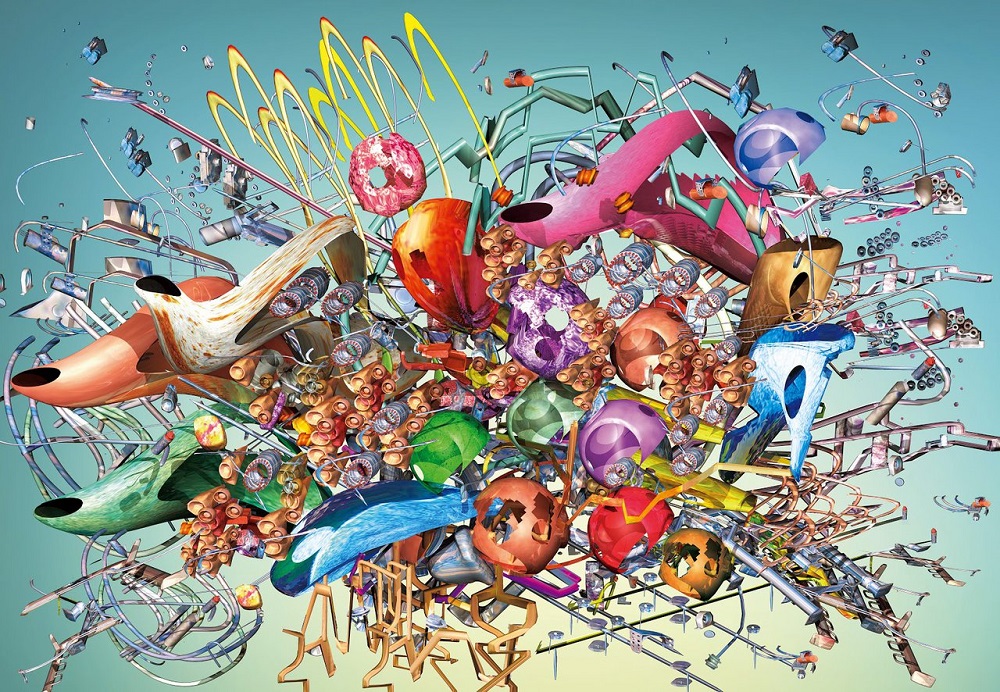
Ryota Matsumoto
First Subtle Sign of Evolving Drones
Architecture, Art & Design – Ryota Matsumoto’s drawings develop and demonstrate the hybrid/multi-layered process where varying scale, juxtaposition of different forms, intertwined textures/tones are applied to reinvent and question the spatial conditions of architectural drawings. His work explore a hybrid drawing technique combining both traditional media (ink, acrylic, and graphite) and digital media (algorithmic processing, scripting and image compositing with custom software ) .
.

Adam Ferriss
Processing Sketch Dump
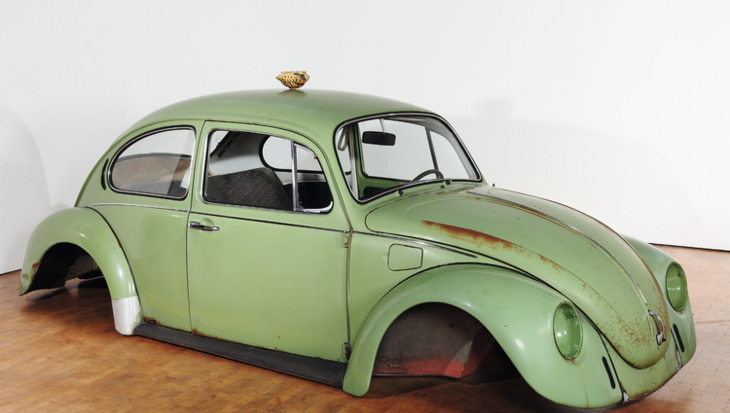
Peter Weibel
Петер Вайбель
Mechanik der Organismen
Peter Weibel followed his artistic thoughts using a wide variety of materials, shapes and techniques. In the mid-1980s, he explored the possibilities of the computer assisting in video processing. In the early 1990s he created an interactive installation based on reality, again showing the relationship between the media and the construction of reality.
In his opinions and articles, Weibel comments on contemporary art, media history and theory, film, video art and philosophy. As a theorist and tutor, he defends an art form that includes in its history, the history of technology and the history of science.

JONAS BOHATSCH
vinyl+ • Expanded Timecode Vinyl
FILE FESTIVAL
A processing sketch is used to generate virtual objects being projected on white timecode-vinyl. These objects can either be placed randomly or by the user via the computer keyboard or an external midi controller. If the record starts to turn, the virtual objects will move with the speed of the record. If a virtual object touches the turntables needle, it will trigger an animation and the playback of a sound. This is possible because the vinyl’s timecode provides information about the record’s playback speed and the position of the needle, thus enabling to synchronize the movement of the turntable with the movement of the projection and to calculate collisions of virtual objects with the turntable’s needle. In vinyl+, an analog medium at the same time acts as a carrier and an interface for virtual audio- and video-objects.
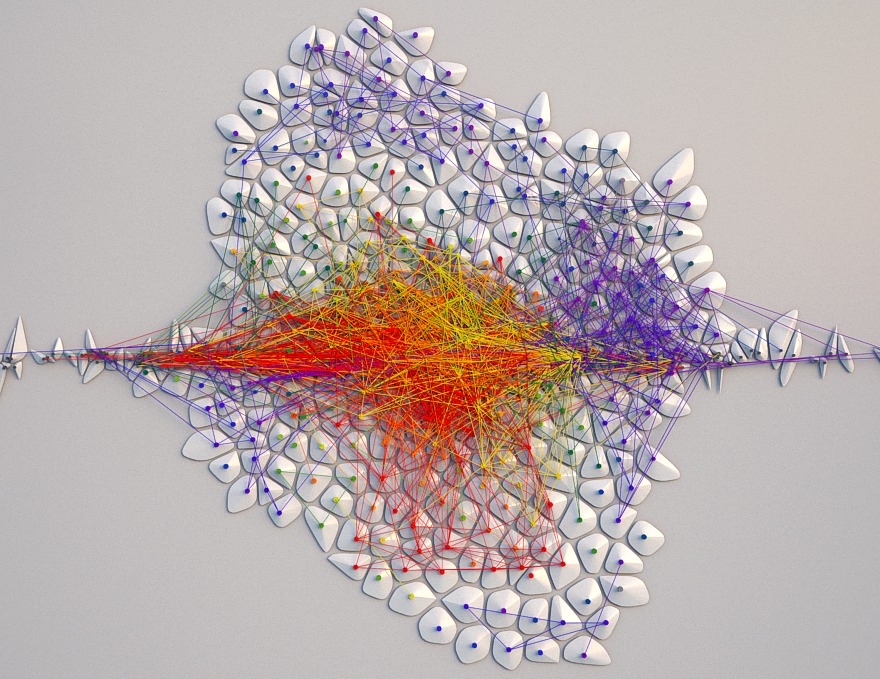
GIUSEPPE RANDAZZO
Джузеппе Рандаццо
transmutation
Transmutation#01 is a generative system composed of two interacting multicellular agents in a Voronoi spatial configuration. Each cell owns a color/saturation information. The cells interact with each other and with the other agent. The two agents are different. The circular one, the most active and in evolution, constantly tries to reorganize its shape and color structures, connecting similar colors in concentric formations. Moreover the saturation and shape of its colors aggregates are influenced by the duration and proximity of the interaction with the other pluricellular agent, whose motion is abstract and immutable. The metaphor at the heart of this system is a reference to the subject of the 2012 Gender Docufilm Festival in Rome, from which the video was commissioned, that precisely addresses the issues related to the the reengineering and the transmutation of the sexual, physical, mental identity, through the collision / confrontation with the external reality. Coded with Processing, rendered with 3Delight (via Processing). In collaboration with Filippo Ulivieri, music by Massimo Dolce.

REZA ALI
EMERGENT
According to wikipedia, “emergence is the way complex systems and patterns arise out of a multiplicity of relatively simple interactions.” Thus “EMERGENT” was created using a particle system that was given basic rules of behavior, this is very similar to swarm algorithms using in architecture to create 3D forms. The application/particle system was created/simulated using Processing and OpenGL. The particle trails (locations over time) were imported to Maya using a MEL script and then animated to show their growth over time. I developed a (pretty complex) Processing application that helped me simulate the particle system (300 particles, with per particle interaction) in real-time.